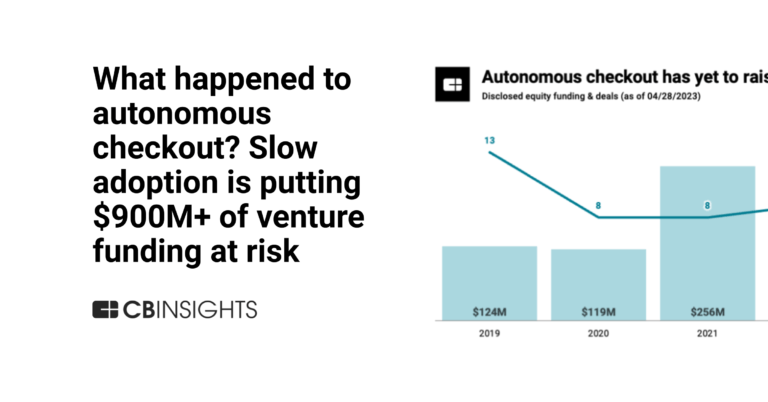
Standard AI
Founded Year
2017Stage
Unattributed VC - III | AliveTotal Raised
$236.32MMosaic Score The Mosaic Score is an algorithm that measures the overall financial health and market potential of private companies.
-51 points in the past 30 days
About Standard AI
Standard AI focuses on transforming the retail industry through artificial intelligence. The company offers a platform that uses artificial intelligence (AI)-powered cameras and deep algorithms to provide checkout-free shopping experiences, real-time reporting on shopper behavior, and insights into inventory and stocks. Its primary services are utilized in the retail sector. It was founded in 2017 and is based in San Francisco, California.
Loading...
ESPs containing Standard AI
The ESP matrix leverages data and analyst insight to identify and rank leading companies in a given technology landscape.
The unattended checkout market develops solutions that enable retailers to offer unmanned point-of-sale and checkout technology. These solutions include self-checkout kiosks, mobile scan-and-pay applications, and computer vision-powered autonomous checkout systems that allow customers to shop and leave without traditional cashier interaction. Companies in this market use technologies such as AI, m…
Standard AI named as Challenger among 15 other companies, including Amazon, Diebold Nixdorf, and NCR Voyix.
Standard AI's Products & Differentiators
Self-Checkout
Standard AI acquired Skip, the world leader in self checkout. The acquisition enables them to provide customers with self-checkout kiosks and cloud-based POS and integrations
Loading...
Research containing Standard AI
Get data-driven expert analysis from the CB Insights Intelligence Unit.
CB Insights Intelligence Analysts have mentioned Standard AI in 1 CB Insights research brief, most recently on May 3, 2023.
Expert Collections containing Standard AI
Expert Collections are analyst-curated lists that highlight the companies you need to know in the most important technology spaces.
Standard AI is included in 12 Expert Collections, including Store tech (In-store retail tech).
Store tech (In-store retail tech)
2,226 items
Companies that make tech solutions to enable brick-and-mortar retail store operations.
Unicorns- Billion Dollar Startups
1,309 items
Grocery Retail Tech
831 items
Startups providing B2B solutions to grocery businesses to improve their store and omni-channel performance. Includes customer analytics platforms, in-store robots, predictive inventory management systems, online enablement for grocers and consumables retailers, and more.
Payments
3,277 items
Companies in this collection provide technology that enables consumers and businesses to pay, collect, automate, and settle transfers of currency, both online and at the physical point-of-sale.
Future Unicorns 2019
50 items
New Retail Formats
368 items
Tech-enabled, physical retail selling formats that reach beyond the walls of a traditional store.
Standard AI Patents
Standard AI has filed 108 patents.
The 3 most popular patent topics include:
- machine learning
- digestive system surgery
- artificial intelligence

Application Date | Grant Date | Title | Related Topics | Status |
|---|---|---|---|---|
5/31/2022 | 4/1/2025 | Electrochemistry, Energy storage, Battery types, Fuel cells, Lithium-ion batteries | Grant |
Application Date | 5/31/2022 |
|---|---|
Grant Date | 4/1/2025 |
Title | |
Related Topics | Electrochemistry, Energy storage, Battery types, Fuel cells, Lithium-ion batteries |
Status | Grant |
Latest Standard AI News
Oct 15, 2025
modular systems that foster easier maintenance and agile innovation. Yet success takes far more than a technical rewrite—the transition often exposes flaws in architecture design, governance and team topology that must be rethought and refined. From “mini monoliths” that replicate legacy dependencies to fragmented ownership models that erode scalability, the real pitfalls of MACH adoption usually stem less from technology than from organizational inertia. Below, members of Forbes Technology Council share the most common failure points they've seen in a MACH transition—and the technical and cultural strategies that can help prevent them. 1. Treating MACH As A Tech Swap One common mistake is treating MACH as a pure tech swap instead of an organizational shift. Companies decouple services but keep siloed teams and waterfall processes, losing the agility MACH enables. The fix: Pair modular tech with cross-functional squads and iterative delivery from day one. - Ashis Ghosh Peanut Robotics 2. Ignoring Architectural Debt The real danger isn't technical debt—it's architectural debt. Too often, teams rush to spin up dozens of services, each with its own database, API and release cycle, but with no clear domain model or governance. The result? A maze of integrations, runaway costs and blame games when things fail. The antidote: Start with architecture, not code. A good architecture firm will save you millions. - Matthew Cloutier Sticky Strategy Forbes Technology Council is an invitation-only community for world-class CIOs, CTOs and technology executives. Do I qualify? 3. Breaking Systems Without Context Companies often rush to break monoliths into MACH without understanding business domains, creating overly granular services that increase complexity and operational overhead. Map business capabilities first, then decompose along natural boundaries. Begin with two or three larger services rather than 20 micro ones. Focus on areas with different scaling needs or release cycles. - Manav Kapoor Amazon 4. Replacing Everything At Once It's a mistake to try to rip and replace everything at once. Instead, adopt a Strangler Fig pattern that gradually replaces components. Don't treat MACH migration like a light switch; treat it like a dimmer. - Aniruddha Maru Standard AI 5. Creating ‘Mini Monoliths' And Overusing Nano Services A common mistake in moving from monolith to MACH is breaking a system into “mini monoliths” without a clear architectural vision. Another is overusing nano services, which adds needless complexity. Both these missteps kill agility. Success lies in incremental decomposition, strong observability and team alignment—rethinking architecture, not just splitting code. - Andrey Kozyrskiy Specific-Group 6. Lifting And Shifting Old Practices One big mistake is treating MACH as just a “tech swap” without rethinking processes and culture. Teams often lift and shift monolith practices into microservices, creating silos and complexity. To avoid this, companies should embrace incremental adoption, strong API governance and cross-functional DevOps practices to ensure agility and scalability. - Diwakar Dwivedi Circular Edge 7. Copying Every Old Feature A big mistake in moving to MACH is trying to copy every old feature, adding too much customization too soon. This makes systems complex, expensive and hard to scale. Start simple—use MACH's built-in strengths, focus on key goals and grow step by step for a cleaner, faster setup. - Amit Samsukha Emizen Tech 8. Moving Too Fast One common mistake companies make when moving from monolithic systems to MACH architecture is trying to do everything at once, without a clear plan. This often results in fragmented systems and unnecessary technical debt. To avoid this, it's best to take things step by step—start with the most important components and focus on aligning the migration with business goals. - Prasad Banala 9. Trading One Monolith For Many The real risk in MACH adoption is trading one monolith for many. Without clear domains and governance, teams create brittle dependencies that stall agility. Instead, drive cohesion by giving each service end-to-end ownership—including its data, contracts and events—while documenting boundaries through ERDs and system maps. This creates autonomy with accountability, enabling resilient, scalable growth. - Tariq Lorgat , Mass Ltd. 10. Carrying Forward Monolithic Thinking A common failure in moving from monolith to MACH is mistaking decomposition for transformation. Companies break code into services but carry forward monolithic thinking—centralized governance, tangled dependencies and pipelines. MACH delivers agility when leaders pair modular architecture with modular culture, automation and DevSecOps discipline; otherwise, you don't get microservices—you get micro-silos. - Aditya Vikram Kashyap , Morgan Stanley 11. Overlooking Business Context A cardinal mistake is focusing solely on architectural robustness and technical requirements. Too many times, teams overlook the broader business context and the value goals driving this modernization. - Muralidharan Nair , LTIMindtree USA 12. Maintaining Departmental Silos One mistake is failing to restructure teams around services and instead keeping the old departmental silos. Having separate frontend, backend and database teams becomes dysfunctional in MACH. Create full-stack service teams that own everything end-to-end. Each team manages their service, from code to production. Conway's Law is real—your architecture mirrors your organization. Change the organizational chart—otherwise, MACH fails culturally. - Marc Fischer Dogtown Media LLC 13. Overlooking Identity Governance One critical mistake? Overlooking identity and policy sprawl during MACH adoption. Decentralized services often multiply IAM roles, API keys and misaligned access policies—creating shadow risk. Security must be composable too. Build a unified access governance layer early, apply least privilege across APIs and treat identity as the new perimeter—otherwise, you trade agility for attack surface. - Swapnil Chawande PG&E 14. Ignoring CX Continuity Here's a hidden mistake: focusing only on tech decomposition and ignoring customer experience continuity. If MACH migration breaks familiar workflows or adds friction, adoption suffers. Mitigate this by mapping end-to-end customer journeys first and aligning MACH rollout to preserve or enhance them. - Anusha Nerella 15. Skipping Contract Definition One mistake is splitting a monolith without defining stable contracts. Teams ship microservices that break each other with unversioned APIs and events and ad hoc payloads. The fix: Go contract-first, and version every API or topic. Use a schema registry and consumer-driven contract tests. Add backward-compatibility gates in continuous integration and have a clear deprecation policy. - Pawan Anand Persistent Systems 16. Adding Too Many Services And Layers A classic mistake in transitioning from monolithic to MACH is including too many services and layers, which creates redundant network latency and overhead. This can be avoided by designing small, with simplicity in mind—splitting out pieces only if they require genuine independence and keeping APIs lean with few hops. - Sid Dixit CopperPoint Insurance 17. Neglecting Developer Experience Companies ditch monoliths for MACH but skimp on developer tools, leaving coders lost in a maze of APIs and pipelines. Fix it with a DevEx portal that unifies documentation, CI/CD and observability. This is key, because bad DevEx kills agility. Empower devs, and MACH's magic flows, scaling fast and smooth. - Durga Krishnamoorthy Cognizant Technology Solutions 18. Applying Old Governance Models A key mistake when shifting to MACH is relying on governance built for monoliths. Old rules stifle agility or create chaos in microservices. Success requires rethinking governance: Define clear patterns, assign accountability and create adaptable structures that guide adoption, unlocking the full power of MACH. - Subasini Periyakaruppan Biotechnology Innovation Organization 19. Overlooking Change Management A common mistake is underestimating the importance of change management during the MACH transition. Companies often focus solely on technology without addressing team dynamics and training needs. To avoid this, implement a structured change management plan that includes regular communication, training sessions and feedback loops to ensure teams adapt effectively to new processes and tools. - Roman Vinogradov Improvado
Standard AI Frequently Asked Questions (FAQ)
When was Standard AI founded?
Standard AI was founded in 2017.
Where is Standard AI's headquarters?
Standard AI's headquarters is located at 548 Market Street, San Francisco.
What is Standard AI's latest funding round?
Standard AI's latest funding round is Unattributed VC - III.
How much did Standard AI raise?
Standard AI raised a total of $236.32M.
Who are the investors of Standard AI?
Investors of Standard AI include Bossa Invest, Sergey Gordeev, Liquid 2 Ventures, Charles River Ventures, Initialized Capital and 15 more.
Who are Standard AI's competitors?
Competitors of Standard AI include Fainders.AI, Sensei, VeriFone, Nomitri, PIXEVIA and 7 more.
What products does Standard AI offer?
Standard AI's products include Self-Checkout and 4 more.
Loading...
Compare Standard AI to Competitors

Trigo provides a computer vision company and operates in retail. It provides a retail automation platform that uses artificial intelligence to identify shopping items with high accuracy, enabling a seamless checkout process and providing valuable retail insights. It provides EasyOut for customer shopping and related services. It primarily sells to the grocery retail industry. Trigo was formerly known as Trigo Vision. It was founded in 2018 and is based in Ramat Gan, Israel.

Zippin provides artificial intelligence (AI)-powered checkout-free technology in the retail sector, focusing on the shopping experience in sports and entertainment venues. The company offers a platform that uses machine learning and sensor fusion to create autonomous shopping solutions, which aim to remove traditional checkout processes and reduce shopping time. Zippin's technology serves the sports and entertainment industry, as well as other retail sectors, including airports, hospitals, colleges, theme parks, and workplaces. Zippin was formerly known as Zyp. It was founded in 2018 and is based in San Francisco, California.

AiFi specializes in autonomous retail technology and operates within the retail and technology sectors. The company offers computer vision solutions that enable retailers to implement frictionless shopping experiences without needing shelf sensors. It primarily sells to the retail industry, providing advanced analytics and AI (artificial intelligence)-powered checkout systems to enhance the shopping experience. The company was founded in 2016 and is based in Burlingame, California.

Inokyo specializes in autonomous checkout technology for the retail sector, aiming to streamline the shopping experience. Its main offerings include a system that tracks customers' virtual carts in real-time and allows for tap and go payments, eliminating the need for traditional checkout processes. Inokyo's solutions cater to a variety of store sizes and are designed to improve operational efficiency and provide valuable customer insights. It was founded in 2018 and is based in San Francisco, California.

Sensei focuses on autonomous retail experiences using computer vision and artificial intelligence (AI) in the retail technology sector. The company provides a system that offers shelf inventory visibility, inventory management, and shopping experiences for customers while ensuring compliance with privacy. Its solutions can be adapted for various retail formats, including supermarkets, workplaces, and mobility hubs. The company was founded in 2017 and is based in Castelo Branco, Portugal.

Mashgin specializes in AI-powered self-checkout systems within the retail automation sector. Its main product leverages 3D vision and deep learning algorithms to recognize items quickly and accurately, aiming to enhance the checkout process by reducing transaction times and increasing retailer revenue. Mashgin's technology is utilized across various sectors, including convenience stores, sports and entertainment venues, and business dining facilities. It was founded in 2014 and is based in Palo Alto, California.
Loading...

